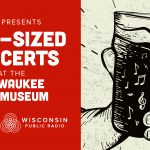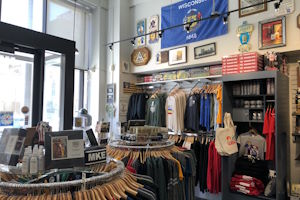2006-11 Vital Source Mag – November 2006
Dangerous ignorance
By Melissa McEwan Recently, Jeff Stein made an alarming revelation in the New York Times: most counterterrorism officials and Congress members to whom he’s spoken don’t know the difference between a Sunni and a Shiite. “For the past several months, I’ve been wrapping up lengthy interviews with Washington counterterrorism officials with a fundamental question: Do you know the difference between a Sunni and a Shiite? “A ‘gotcha’ question? Perhaps. But if knowing your enemy is the most basic rule of war, I don’t think it’s out of bounds. And as I quickly explain to my subjects, I’m not looking for theological explanations, just the basics: Who’s on what side today, and what does each want? “…But so far, most American officials I’ve interviewed don’t have a clue. That includes not just intelligence and law enforcement officials, but also members of Congress who have important roles overseeing our spy agencies. How can they do their jobs without knowing the basics?” As Stein correctly notes, it would have been incredible for British counterterrorism officials dealing with Northern Ireland not to know the difference between Catholics and Protestants. And yet one of the fundamental differences driving the civil war in Iraq and delineating disparate interests between – for example, Hezbollah and Al Qaeda – are not understood by many of our counterterrorism officials – and members of Congress in key positions relating to intelligence and defense. “Take Representative Terry Everett, a seven-term Alabama Republican who is vice chairman of the House intelligence subcommittee on technical and tactical intelligence. “Do you know the difference between a Sunni and a Shiite? I asked him a few weeks ago. “Mr. Everett responded with a low chuckle. He thought for a moment: ‘One’s in one location, another’s in another location. No, to be honest with you, I don’t know. I thought it was differences in their religion, different families or something.’ “To his credit, he asked me to explain the differences. I told him briefly about the schism that developed after the death of the Prophet Muhammad, and how Iraq and Iran are majority Shiite nations while the rest of the Muslim world is mostly Sunni. ‘Now that you’ve explained it to me,’ he replied, ‘what occurs to me is that it makes what we’re doing over there extremely difficult, not only in Iraq but that whole area.’” Gee, ya think? As Tristero at Hullabaloo notes: “Immediately after the 9/11 attacks, when the sound of the military airplanes patrolling the skies of Manhattan were still traumatizing everyone, I picked up some books on bin Laden, the Middle East, and Islam. I also peppered with questions the few people I knew back then who had some expertise on the subjects. In fact, lots of people I knew were doing the same thing; we were passing around books, articles, and clippings, emailing links to each other. This strikes me as totally unremarkable behavior.” It strikes me the same way. And, beyond what one would expect in terms of self-education […]
Nov 1st, 2006 by Vital ArchivesDeep Roots
By Blaine Schultz + Photos by Kat Berger “Be fruitful and multiply, and fill the earth and subdue it” Genesis 1:28 Popular music, semi-popular music and even obscure music all seem to run in cycles. Immigrants first arriving in this country from the British Isles brought folk ballads with them. African slaves carried their own musical traditions, which included the distinctly characterizing Americana sound of the banjo. From these various foundations grew the structures of Americana music today. In 1927, Ralph Peer set up recording sessions in Bristol, Tennessee and hit not one, but two grand slams by recording The Carter Family and Jimmie Rodgers. Dubbed the “Big Bang” of country, Peer’s sessions with these future music superstars put hillbilly music on the map. Meanwhile in New Orleans, cornet player Buddy Bolden was never recorded. His legend alone lives on. To trace the history of American roots music, one must go to the source—the Mississippi River. As cities grew up along the waterway, so did the music, from New Orleans to St. Louis to Chicago. East of the river, Philadelphia and rural Appalachia developed their own voices, and New York City was a major focal point for both nightlife and the business of music. Nashville and Memphis would later play significant roles. West of the river, outposts in Kansas City, Tulsa and later Austin shouted regional sounds, as Los Angeles settled in as Showbiz Central. In the 1950s, teenagers finally had a little spare change and rock & roll dug in, fueled by fast cars and fast-talking DJs. Parents began scratching their heads, and things haven’t been the same since. Milwaukee itself supports a vibrant roots scene, with music from all over that spectrum available for your listening pleasure just about any night of the week. From smoky blues clubs in the central city to bars in Riverwest and coffee houses everywhere, folkies, thrift store hillbillies, suit-sporting wailers and flannel-shirted rockers throw down the music that defines the American sound. Each band or artist brings their own interpretation and vision to the music they play. For this story, VITAL spoke with over a dozen players and asked them each the same four questions. What follows is a glimpse into the music that’s helped to shape the Milwaukee music scene for over 20 years. DEFINE YOUR MUSIC. John Sieger I’m trying to locate that line that runs halfway along the American racial divide about 50 years ago. I’ve avoided steel guitars and fiddles like the plague because that tips the balance. Horns are acceptable but hard to find. Slide guitar is wrong for me, because it’s easy to cheat. I’m pretty specific about things. Ray Charles and Buddy, I mean Charlie, Rich had it exactly right. Jason Mohr – Juniper Tar Folk-influenced rock with punk, country and noise backbones. Bobby Rivera – Bobby Rivera and the Rivieras I’ve played a lot of different material in many different bands. My primary stuff right now is the rock & roll instrumental stuff, western […]
Nov 1st, 2006 by Vital ArchivesWillie Nelson
By Jon M. Gilbertson For anyone who loved Willie Nelson’s 1978 classic Stardust – the country legend’s first successful attempt to interpret truly great songwriters – the prospect of Songbird is mouthwatering. Not only is he taking on more contemporary tracks by the likes of Leonard Cohen and Gram Parsons, but he’s also getting assistance from Ryan Adams and Adams’ backup band, the Cardinals. While Adams often comes off like an arrogant prick, he does share key qualities with Nelson, such as a fondness for recording as many albums as he possibly can and a broad yet discriminating love for any music that’s good. Adams also produces Songbird unobtrusively, unlike some studio mavens (Daniel Lanois, for example) to whom Nelson has previously given relatively free rein. With the Cardinals alternating between sheer brawn and dulcet subtlety, and with regular harmonica player Mickey Raphael accompanying him, Nelson glides through a raucous take on Parsons’ “$1,000 Wedding,” a simple gospel-hush version of Cohen’s “Hallelujah” and a perfectly pitched waltz-time cover of Harlan Howard’s “Yours Love” with an easy grace unmatched by anyone this side of Tony Bennett. Adams and the Cardinals set up a kind of consistency on Songbird that allows a few of Nelson’s own compositions and even a new one by Adams, “Blue Hotel,” to sit well alongside the interpretations. If this album isn’t quite the achievement that Stardust was, and if Nelson’s voice isn’t entirely what it once was, Songbird still offers the sound of an American icon taking unmistakable pleasure in his craft, and using it on the art of others.
Nov 1st, 2006 by Vital ArchivesScissor Sisters
By Nikki Butgereit Ta-Dah, the second album from the Scissor Sisters, is highly produced, uber-stylized and no less creative and fresh than their first. The songs are kitschy, cheesy and overwhelmingly disco, but they work. The perky catchiness of Ta-Dah is undeniable. “I Don’t Feel Like Dancing” is the ideal opener to an album that makes you want to move. The kooky drum machine fills and raygun blasts are a perfect complement to the song’s beat. Although Elton John is credited with co-writing and playing piano on “Dancing,” the second track, “She’s My Man,” also reeks of his influence. Just like with their self-titled debut, Ta-Dah features more creatively funky songs between the straight-up dance tracks and ballads. It’s this juxtaposition that makes the Scissor Sisters fun; you’re never quite sure what they’ll try next. “I Can’t Decide” combines a vaudevillian piano melody with murderous lyrics – one of the many odd contrasts that are fast becoming the group’s trademark. On “Kiss You Off,” Ana Matronic channels Debbie Harry in a tribute to Blondie in both sound and girl-power lyrics. Ta-Dah has an overtly sexual tone, sneaking raunchy lyrics into the peppy pop songs. Yet the bawdiness is balanced out by the sweetness of other tracks. “Land Of A Thousand Words” is tailor-made for a prom scene in an 80s movie. “The Other Side” is an electronic groove carrying a romantic message that’s at odds with other songs on the album. Ta-Dah reinforces the idea that the world will always need party music. And The Scissor Sisters are just the band to provide it.
Nov 1st, 2006 by Vital ArchivesThe Who
By Jon M. Gilbertson Strictly speaking, Endless Wire is the first full Who album in 24 years. But strictly speaking, it’s not an album made by the Who. And while it may be true that nobody is absolutely irreplaceable, the dearly departed Who rhythm section of drummer Keith Moon and bassist John Entwistle come close. So what, or Who, remains? These days it’s just singer Roger Daltrey and guitarist, songwriter and general mastermind Pete Townshend. With the support of a few other musicians, politely listed in “Principal” and “Guest” classifications, they continue the group name. The recognizable group sound is another matter. Age is a sigificant but not overwhelming part of the complication. Daltrey has never had an overtly beautiful voice, but he’s always had a hoarse sort of expressiveness, and that hasn’t changed. Townshend has, for obvious reasons (hearing impairment, for one), muted his power chords, but can still find a precise electric blues line or an eloquently simple acoustic progression. Townshend does less well, however, when trying to frame the songs that rely for support upon whatever melodies he can wrest from his guitar(s). The latter half of Endless Wire is taken up with “Wire & Glass,” a mini-opera (not a la “A Quick One While He’s Away” ) that seems constantly to be looking back on old, familiar themes: rock & roll, the deceptive innocence of youth, the inexorable decay of years. The themes are not without interest, but Townshend can’t make them coalesce. He never really could, as proven by Tommy and Quadrophenia and even his solo album White City, but that music was strong enough to leap the narrative and intellectual gaps. This music – even the first half of Endless Wire, which is given over to more various thoughts and more varied songs than “Wire & Glass” – favors sub-thematic structure over genuine artistry. The most glaring difference between the modern Who and the old Who, besides the absent cohorts, is that their music now offers moments and flashes rather than journeys and explosions. It presents the lovely bitter folk music of “A Man in a Purple Dress” and the soft coda of “Tea & Theatre.” In another 24 years, Who’s Next and Empty Glass will probably remain in the collective memory. Endless Wire probably won’t.
Nov 1st, 2006 by Vital ArchivesLloyd Cole
By Blaine Schultz Lloyd Cole and the Commotions’ 1984 debut album, Rattlesnakes, garnered a good amount of airplay (both on college radio and MTV) and press. In the years that followed, this competent record would be lionized as a masterpiece. In hindsight, the dude had a ways to go. Twenty-plus years and a dozen albums find Cole releasing another sophisticated pop album. Or mature pop album. Or literate pop album. Let’s just say that, lyrically, Cole comes across as pretty sincere… verging on humorless. He is content to merely litter the landscape – dropping hip, young urban references whenever he gets the chance. His jumbles of words come off like a blatant attempt to impress the listener. Covering Moby Grape’s “I Am Not Willing,” he sings of a romantic breakup: “I’m so grateful, no longer willing to have a home,” relieved that she gave him a reason to split. The very next song, “Slip Away,” offers this: “I propose an exit strategy… to slip into the ether where I belong.” Maybe only a true artist can blur the lines between woe-is-me and self-satisfied sneer. Maybe Lloyd Cole is that artist… Maybe. But a typical album is a good year’s hard work, so let’s not pitch this disc into the landfill just yet. Musically and sonically, the album is brilliant. The stylish arrangements build on Cole’s modern folk tunes, adding brushed drums here, textured keyboards there and even a richly impressive string section on a few tracks. Rhythms lean toward bossa nova, while subtle loops and delayed guitar riffs add to the palette. If you can get beyond the lyrics, Antidepressant would be perfect listening in a Starbucks or Barnes & Noble.
Nov 1st, 2006 by Vital ArchivesJoanna Newsom
By Erin Wolf When one insists on being called a “harper” rather than a harpist and becomes peeved when told that one sounds “childlike” (“Bjork-ish,” too) even though the description is nail-on-the-head, it’s obvious one’s perception of oneself is a tad bit off-kilter. Some would call this stubborn, some would call it quirky; most would call it self-absorbed. This self-absorption, though, is just what makes Joanna Newsom’s music work. Her first two EPs and full-length album, The Milk-Eyed Mender, were studies of self-absorption, created from a world not known to anyone other than the 24-year-old herself, characterized by music and lyrics straight out of the writings of Homer and a “childlike” voice more like a infantile gnome with a bad cold piped in between harp pluckings. To write music that sounds centuries old, the writer must obviously not be spending too much time watching television. Going from the intriguing base that is her first album, Newsom’s latest, Ys, is a wash of strings and rich orchestral sounds, surrounding the ever-plucky “harper’s” own string manipulations and warbling. Ys was produced and mixed by Steve Albini (!) and Jim O’Rourke, and adding even more magical elements with string arrangements was Van Dyke Parks of Beach Boys fame. Blending lyrics that are pure poetry (“there is a rusty light on the pines tonight / sun pouring wine, lord, or marrow / down into the bones of the birches and the spires of the churches”) and music arranged in a manner that resembles an old school Disney score takes incredible patience and craft. It also takes incredible patience on the listener’s part, as most of the songs clock in between 7 and 17 minutes long. It is worth it to be patient with Ys, though. It is an album meant to be reflected upon, for it has definite stories to tell. There’s a slim to none chance that the five songs featured here will ever make it to Top 40 radio, but this is just exemplary of the diamond in the rough quality Ys possesses.
Nov 1st, 2006 by Vital ArchivesAnd trade “them” for what?
By Jon Anne Willow Dear Readers, Being a monthly publication has its disadvantages of timing. Never is this more apparent to me than when I have to write this column before a momentous event, knowing most people won’t read it until after. Such is the case with these midterm elections. As of this morning, both liberal and conservative think tanks are predicting that Democrats will pick up 18-22 seats in the House (15 are needed for a majority) and 2-3 seats in the Senate (of the six needed for a majority). In short, by the time you read this, it’s likely that Democrats will take back one of the houses and hold a stronger position in the other. It would seem that change is in the air. But I’m troubled. The other evening, VITAL hosted a screening of Robert Greenwald’s Iraq For Sale: The War Profiteers to a packed room at Bremen Café. Granted, this is pretty far-left stuff, attracting mostly those who already know they’re mad as hell and aren’t going to take it anymore, so I wasn’t surprised that the lively talkback session after the film touched on wholesale revolution in the streets. But as PeaceAction’s George Martin whipped up the crowd with enthusiastically rejoined calls to “Send them home!” I couldn’t help but ask: And trade “them” for what? Is our collective memory so short that we’ve forgotten that Republicans rode into Washington in 1994 as reformists, vowing to end a very real decade of Democratic power-mongering and scandal? Does anyone recall that even though Democrats are campaigning on Bush’s poor handling of the “War on Terror,” 145 of 211 Democratic Representatives voted in favor of the 2001 USA PATRIOT Act and only one Senator against? Or that 66 Democrats in the House voted in favor of the reauthorization in 2005 and only three Democratic Senators against? Are we impressed today by Congressmen like Sherrod Brown (D-Ohio), who positions himself as the “People’s Defender” yet voted in favor of Bush’s recent evisceration of the Constitution as it pertains to prisoners of war? Will Democratic voters, at some point, acknowledge the irony of their present mood? Let’s put this in perspective. This election serves one very valuable purpose: to restore some modicum of party balance within the three branches of our federal government. But a Democratic House will not have the power to make sweeping changes to our domestic policies on health, education, jobs, campaign reform and the federal budget. And even if the will to do so is there, this cash-strapped nation is so committed to military spending at this point that to withdraw significant funding from the war to reallocate it to domestic interests would potentially put the lives of our deployed soldiers in even greater peril. I’ll lay down money that few Democrats with future political aspirations will take up that charge, for fear of alienating their home base and drawing easy fire from angry, organized Republicans. It’s all very interesting. While I applaud the […]
Nov 1st, 2006 by Jon Anne Willow




















